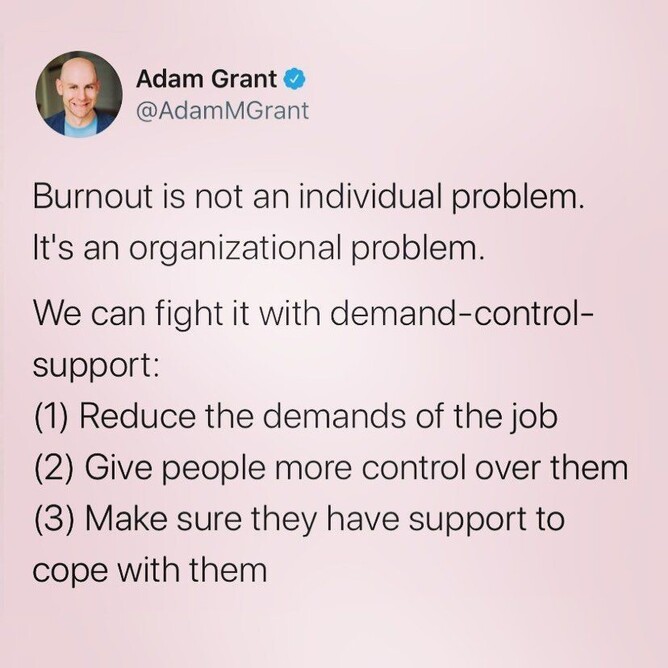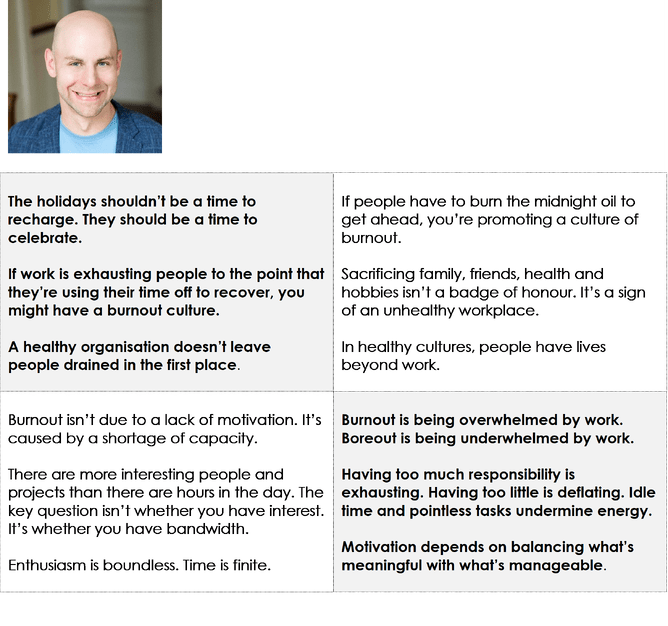In this article I’m taking a look at burnout and asking what senior leaders in health care businesses are doing or can do to guard against this impacting their most important resource, their employees.
One of Simon Sinek’s many thought provoking posts on LinkedIn says, “If we don’t understand people, we don’t understand business.” So, how well do we understand and can support those people in our health care businesses who may be heading towards burnout especially in this heightened time of uncertainty with Covid 19 coupled with skiiled clinical staff shortages?
The Reserch
The following contains extracts from a New Zealand Herald article dated the 30th April 2021. The article is titled, “Feeling the burnout: More than 1 in 10 New Zealanders are stressed at work.”
New research out of AUT suggests 11 per cent of New Zealand workers might be experiencing burnout. At greatest risk of burnout are managers (219 per cent more likely to be burned out). The article also mentions essential workers were over 150 per cent more likely to be burned out than the average worker. This could be blamed on Covid 19 but an earlier survey by Southern Cross and BusinessNZ's joint 2019 Workplace Wellness report showed a 23.5 per cent rise in stress across businesses over the preceding two years.
Professor Jarrod Haar of AUT's business school outlined four signs of burnout:
- Emotional exhaustion,
- Trouble staying focused,
- A lack of emotional control, and
- Indifference to work.
If workers score highly across all these areas, the diagnosis is clear: they've got nothing more to give. The lead up to burnout means an employee is likely to get less done and make more mistakes. Eventually they start to think of quitting or worse, the employer does not identify the issue and incorrectly manages the affected employee out of the business due to a perception of poor performance.
The New Zealand Herald article notes that the World Health Organisation includes burnout in its most recent International Classification of Diseases (ICD-11), adding that sufferers can also experience "reduced professional efficacy" and energy depletion. Burnout is "not classified as a medical condition", but it's still an occupational phenomenon with physical and mental risks.
Misunderstanding Burnout
At the core of burnout is emotional exhaustion and like many mental health issues signs can be barely visible to others. Burnout has been linked to depression, memory loss, sleep problems, alcohol abuse, weakened immune system and even cardio vascular disease.
Basically, it is a sense of exhaustion that doesn’t go away with a good night sleep or a weeks’ vacation relaxing on the beach in the sunny Cook Islands.
Let’s talk about Liz
Think of a great manager that once worked for your company. For this illustration we’ll call the manager Liz and Liz is a Clinical Nurse Manager in either aged care or primary health, it doesn’t really matter which. Liz has delivered consistently and positively for your healthcare business and its success for years.
Recently Liz has started to exhibit some concerning performance issues. On top of this Liz just doesn’t seem that motivated. You organise a meeting and talk to Liz about her performance and she promises to improve. Liz gets a bit upset and through tears mentions work has been pretty full on and she’s been getting quite tired. A Registered Nurse shortage has caused gaps in the rosters and Liz has been filling many of these gaps herself. You remind Liz that this is an industry wide issue. Being the great leader you are, you say, “May be take a couple days leave Liz. I’m sure you’ll be as good as gold after that.”
A short period later you are still not seeing any discernible improvement and you drop Liz an email to organise another meeting. To your surprise Liz suddenly resigns. You talk to her about it but secretly you are relieved she has resigned as this has taken away the hassle of possibly performance managing Liz out of the business. You quickly get on to HR to start the recruitment process to replace Liz.
We’ll come back to Liz later in this article.
I wonder if the issue we have in New Zealand is that traditionally burnout has been misunderstood as a “feeling of wanting to give up” and “giving up” is not something kiwi employers like to see. In fact it is more likely to result in a negative and misguided response or action.
Understanding Burnout
How can your organisation and its senior leaders ensure they are there to identify and support employees that are on the darkening path to burnout?
This is the point in the article where I would strongly recommend you invest 40 minutes, now if you can, listening to Adam Grant's fantastic Ted Talk, "Burnout is everyone's problem" as it provides a simple yet powerful three step guide for assisting your company combat employee burnout. These steps need to be embedded in company culture. The following link will take you to that TED talk.
Adam Grant notes burnout is a problem of your circumstances rather than something buried in your head. He stresses that burnout does not originate in how we deal with stress whether through long working hours and/or other more psychological pressures like struggling to provide the best care due to understaffing.
He stresses that it is reflective of the job and work environment and therefore is reflective of an organisational problem. If you have symptoms of burnout this is likely due to your organisation having some practices or people that fuel burnout.
In the TED talk Adam clarifies that we should not be confusing stress with burnout. Feeling overwhelmed sometimes is normal as it signals responsible engagement in meaningful work. Burnout is persistent, impairing emotional exhaustion. It stems from too many demands and too little control and support.
He then discusses a three step framework which starts with 1) reduce the DEMANDs of the job, 2) give employees more CONTROL over these demands, and if the first two are too difficult to reduce or simply part of the job, 3) make sure the employee has SUPPORT to cope with the demand of their job.
Back to Liz with Demand – Control – Support
Let us now go back to Liz. When you first talked to Liz about her performance issues she was upset and said that her work was full on due to a Registered Nurse shortage and that she was getting quite tired but she had promised to improve.
Earlier in this article we outlined the four signs of burnout as emotional exhaustion, a lack of emotional control, indifference to work and trouble staying focused. Based on how Liz was feeling it would seem she could be suffering from at least three of the four signs of burnout.
Adam Grant notes that “Your work place is often responsible for the cause of burnout – they should take responsibility for the cures.”
If the organisation you work for had a strong understanding of burnout due to embedding this knowledge in its company culture and had ensured all of the senior leaders were trained in identifying the signs of burnout, using the demand, control support steps would have greatly helped with identifying and assisting Liz at the first meeting.
In fact, a proactive work environment would have picked up that all of their Clinical Nurse Managers were currently in a difficult position managing the demands of their role in conjunction with registered nurse shortages and that these shortages would impact an ability to control the demands. This in turn would be understood by the senior leaders as a recipe for burnout proactive support was required for all Clinical Nurse Managers.
In a health care business with an embedded understanding how to combat burnout through the steps of “demand, control and support”, Liz would have felt supported, that the demands were understood and that something proactive was being done about it. And what health care business can afford to lose good people due to what can only be called an organisational failure?
Here are some recent quotes on Twitter by Adam Grant:
My take away from burnout
The four most important learning points I would like to conclude this article with are as follows:
- Embed into your company culture the “demand – control – support” steps – Along with the TED talk by Adam Grant, there is a lot of information and resource available for your HR team or external training provider to be able to prepare the necessary ongoing training resource to ensure a culture where there is a zero tolerance to burnout.
- Proactively combat burnout – This is a focus on your own personal mental and physical health. You need to be exercising regularly through your week and during the day set aside at least one hour to disengage from work. Watch what you eat and drink. And family and "you" time too is non-negotiable each and every day.
- Know the signs of burnout – I have a friend who experienced burnout about 15 years ago. Now he can tell when he is heading towards burnout. He feels a sense of reducing elasticity in his thinking and decision making. When the signs appear, it is not time to book a vacation rather look at the current work demands and what needs adjustment to regain control.
- Ensure that employee welfare is more important than the dollars – Ensure the Board of directors and senior management team have “people” as the most important point on their regular meeting agenda and not the dollars. In fact, “people” as an agenda item should be discussed directly after approving the minutes of the last meeting and before anything else. 1) Why there is turnover, 2) what are the current work pressures and how long are they expected for and 3) discussion about "people at risk" using the demand, control, support guide.
I started with a Simon Sinek thought provoking LinkedIn post and will now end with “We become leaders the day we decide to help people grow, not numbers.”
My view, even when CFO, was that numbers are the trailing indicator of a business’s success anyway! And frankly, I can only see a positive return on investment for a health care business that has an imbedded culture of zero tolerance to burnout and therefore happy and well supported employees!
------------------------------------------
Stuart Bilbrough
Peak Care Advisory
Mob: 021 252 5778
Email: stuart@peakadvisory.co.nz
Website: www.peakadvisory.co.nz
31st January 2022






